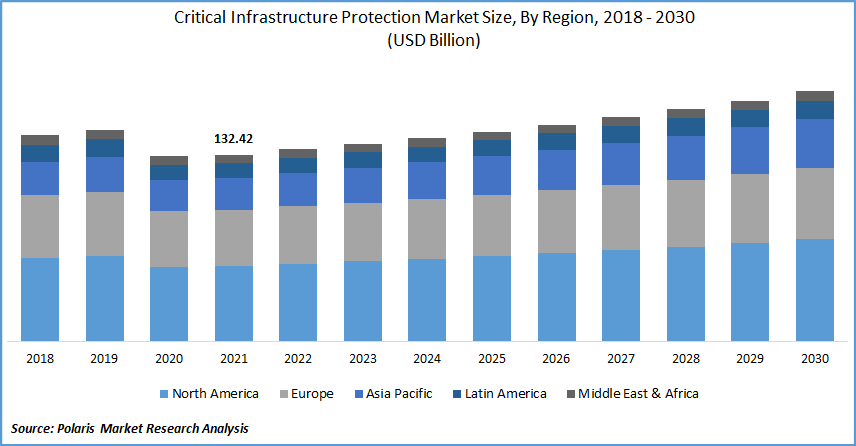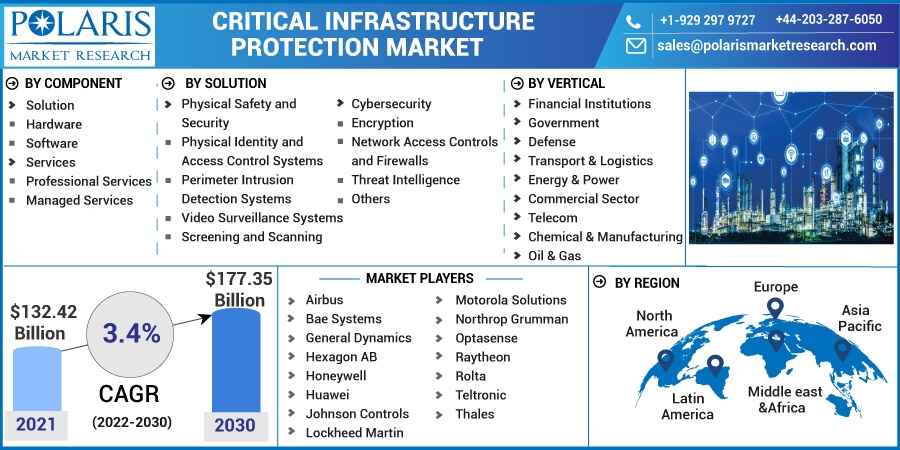
Critical Infrastructure Protection Market Share, Size, Trends, Industry Analysis Report, By Component (Solution, Services); By Solution (Physical Safety and Security, Cybersecurity); By Vertical; By Region; Segment Forecast, 2022 - 2030
- Published Date:May-2022
- Pages: 116
- Format: PDF
- Report ID: PM2415
- Base Year: 2021
- Historical Data: 2018 - 2020
Report Outlook
The global critical infrastructure protection market was valued at USD 132.42 billion in 2021 and is expected to grow at a CAGR of 3.4% during the forecast period. The rising threat of disruption in cyber security is the major driving factor for the industry growth in the forecast period.
 Know more about this report: Request for sample pages
Know more about this report: Request for sample pages
As the requirement for the protection of critical infrastructure, physical & cyber systems are rising due to natural disasters, terrorist attacks and cyber hackers are growing, which has debilitating impacts on economic security and public health. Thus, the demand for critical infrastructure protection across various end-user industries is rising globally.
It includes healthcare, financial institutions, defense, energy & power, commercial sector, chemical manufacturing, oil & gas, transport, and others. Moreover, strict government regulations towards public protection play a vital role in boosting CIP industry demand. Additionally, rising government and private investments in the security sector are enhancing industry expansion. Along with these rising R&D activities toward the safety & security sector is pushing the critical infrastructure protection industry growth across the world in projected years.
The pandemic has drastically affected the critical and cybersecurity infrastructure protection which is delivered to users and organizations for accelerating cloud adoption and fast-tracking remote workforce. With various end-user industries adopting work from home policy, there has been an increase in critical infrastructure protection industry demand, which includes cloud-based systems. Additionally, the threat of cybercrime has also increased; thereby, companies and venture capitalists are investing more in insecurity.
Moreover, during a pandemic, the risk of external terrorist attacks has also increased due to retraction in the movement of cybersecurity forces which pushes the requirement of security toward critical physical infrastructures protection and human-less monitoring, which will enhance the adoption of critical infrastructure protection solutions. However, gradual openings of lockdown and post lockdown due to a social gathering of the public will foster the demand for critical infrastructure protection markets across the world.
 Know more about this report: Request for sample pages
Know more about this report: Request for sample pages
Industry Dynamics
Growth Drivers
The rising penetration of preventive & curative drugs, rising purchase of fast-track approval of diagnostics, and demand for critical care devices have presented beneficial industry growth. Moreover, the growing stringent government regulations towards the adoptio0n of CIP solutions have enhanced the critical infrastructure protection industry expansion.
Additionally, rising work from home and digitalization provide the impetus for industry growth. Further, the rapid growth and adoption of cloud technology and IoT devices by various end-user industries foster the demand across the world. For instance: According to Cybersecurity Ventures, in 2021, various countries such as Japan and the UK are struggling to find trained cybersecurity experts.
As the number of un-filled jobs offering work from home is estimated to reach 3.5 million. Additionally, according to the report of the Australian Strategic Policy Institute (ASPI) in 2019, it is found that the Australian critical infrastructure providers have deficient IoT security skills and are not skilled to respond to critical infrastructure incidents.
Therefore, with the abovementioned rising factors, the critical infrastructure protection market is expected to grow in the forthcoming years. Along with this, according to National Centres for Environmental Information in 2021, the increasing number of climatic disaster events is a major challenge for the nation’s critical infrastructure protection system.
Report Segmentation
The market is primarily segmented on the basis of component, solution, vertical, and region.
|
By Component |
By Solution |
By Vertical |
By Region |
|
|
|
|
Know more about this report: Request for sample pages
Insight by Solution
The cybersecurity segment is recorded to hold the largest revenue share. The rising digitalization across the various private and government sectors globally will enhance the market adoption in the forecast period. The rapid technological advancement has risen the number of hackers, which enhances the cybercrimes are the foremost factors that offer various opportunities for the segment growth around the world.
The physical safety and security segment is projected to exhibit a progressive growth rate in the forecasting years. The threat of life from natural disasters is the major factor pushing the segment growth in the critical infrastructure protection market. On the other hand, due to changing climatic conditions, the incidences of natural disasters are also rising, such as floods, drought, etc., which thereby fosters industry growth. Moreover, increasing investments in R&D activities, as well as the emergence of various novel technologies for protection and security, are acting as catalyzing factors for segment growth in the near future.
Geographic Overview
North America accounted for the largest revenue share in the global CIP market. With the rising cybercrimes and attacks, governments of various countries across the region are anticipated to impose stringent regulations within the public and private sectors, which will surge the market demand. Additionally, rising investment in public protection is creating opportunities for players in the market. Various end-use industries operating in the cybersecurity industry focus on R&D, which provides lucrative CIP market growth to both business and technical innovations.
For instance, according to the Institute for Electric Innovation (IEI), the penetration of installed smart meters was estimated to rise from USD 98 million to USD 107 million during 2019-2020. It includes the expansion of market players such as Energy Advanced Metering Infrastructure (AMI), Salt River Project (SRP), and AEP Ohio. These projects are in the US cities, such as Ohio, Louisiana, Texas, and Mississippi.
Moreover, the Asia Pacific market is anticipated to exhibit the highest CAGR over the forecasting years. The rapid technological development in defense and industrial systems are some of the major driving factors surging the growth across the region. It is found that various developing and developed countries such as China and India are estimated to be the site of a high growth rate with rising investments in defense and critical infrastructure protection software and hardware.
The market players are more focused on their geographical expansion in the Asia Pacific, which enhances the market expansion. The Asia Pacific is leading in the adoption of digitalization which includes South Korea with 95% population, Israel with 88% population and followed by China, India, etc. Hence, the increasing proliferation of the internet and rising acceptance of the developing technologies by the population is fueling the market demand in the forthcoming scenario.
Competitive Insight
Some of the major players operating in the global market include Airbus, Bae Systems, General Dynamics, Hexagon AB, Honeywell, Huawei, Johnson Controls, Lockheed Martin, Motorola Solutions, Northrop Grumman, Optasense, Raytheon, Rolta, Teltronic, and Thales.
Critical Infrastructure Protection Market Report Scope
|
Report Attributes |
Details |
|
Market size value in 2021 |
USD 132.42 Billion |
|
Revenue forecast in 2030 |
USD 177.35 Billion |
|
CAGR |
3.4% from 2022 - 2030 |
|
Base year |
2021 |
|
Historical data |
2018 - 2020 |
|
Forecast period |
2022 - 2030 |
|
Quantitative units |
Revenue in USD Billion and CAGR from 2022 to 2030 |
|
Segments covered |
By Component, By Solution, By Vertical, By Region |
|
Regional scope |
North America, Europe, Asia Pacific, Latin America, Middle East & Africa |
|
Key companies |
Airbus, Bae Systems, General Dynamics, Hexagon AB, Honeywell, Huawei, Johnson Controls, Lockheed Martin, Motorola Solutions, Northrop Grumman, Optasense, Raytheon, Rolta, Teltronic, and Thales. |
